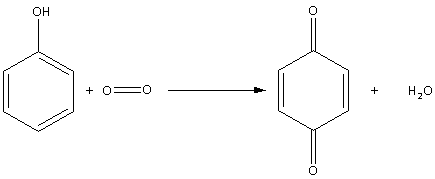
Phenol on oxidation in air gives:
A. Quinone
B. Catechol
C. Resorcinol
D. o-cresol
Answer
567.9k+ views
Hint: Phenol is an aromatic compound having a hydroxyl group $\left( { - {\text{OH}}} \right)$ attached to the aromatic ring. The hydroxyl group is an electron-donating substituent. Oxidation of phenol in air means reaction of phenol with ${{\text{O}}_{\text{2}}}$.
Complete step by step answer:
Phenol is an aromatic compound having a hydroxyl group $\left( { - {\text{OH}}} \right)$ attached to the aromatic ring. The hydroxyl group is an electron-donating substituent. As an electron-donating substituent is attached, the nucleophilic character of the aromatic ring increases.
Thus, the oxidation of phenol in air is as follows:

During oxidation of phenol in air, quinone (1,4-benzoquinone) is produced.
So, the correct answer is Option A.
Additional Information:
Catechol is dihydroxybenzene. Oxidation of catechol in air also produces quinone (1,2-benzoquinone). The oxidation of catechol in air is as follows:

Note:
Quinones are oxidative derivatives of phenols. Quinones are not aromatic in nature as its bond lengths are different. The carbonyl $\left( {{\text{C}} = {\text{O}}} \right)$ bonds in quinone are always double bonds and the carbon-carbon bonds \[\left( {{\text{C}} - {\text{C}}} \right)\] next to the carbonyl bonds are always single bonds. Quinones are not aromatic but they are conjugated.
Phenol when stored in air turns pink in color. Because when stored in air phenol oxidized to quinone. The color of quinone is pink.
Complete step by step answer:
Phenol is an aromatic compound having a hydroxyl group $\left( { - {\text{OH}}} \right)$ attached to the aromatic ring. The hydroxyl group is an electron-donating substituent. As an electron-donating substituent is attached, the nucleophilic character of the aromatic ring increases.
Thus, the oxidation of phenol in air is as follows:

During oxidation of phenol in air, quinone (1,4-benzoquinone) is produced.
So, the correct answer is Option A.
Additional Information:
Catechol is dihydroxybenzene. Oxidation of catechol in air also produces quinone (1,2-benzoquinone). The oxidation of catechol in air is as follows:

Note:
Quinones are oxidative derivatives of phenols. Quinones are not aromatic in nature as its bond lengths are different. The carbonyl $\left( {{\text{C}} = {\text{O}}} \right)$ bonds in quinone are always double bonds and the carbon-carbon bonds \[\left( {{\text{C}} - {\text{C}}} \right)\] next to the carbonyl bonds are always single bonds. Quinones are not aromatic but they are conjugated.
Phenol when stored in air turns pink in color. Because when stored in air phenol oxidized to quinone. The color of quinone is pink.
Recently Updated Pages
Why is there a time difference of about 5 hours between class 10 social science CBSE

In cricket, what is a "pink ball" primarily used for?

In cricket, what is the "new ball" phase?

In cricket, what is a "death over"?

What is the "Powerplay" in T20 cricket?

In cricket, what is a "super over"?

Trending doubts
What is meant by exothermic and endothermic reactions class 11 chemistry CBSE

10 examples of friction in our daily life

One Metric ton is equal to kg A 10000 B 1000 C 100 class 11 physics CBSE

1 Quintal is equal to a 110 kg b 10 kg c 100kg d 1000 class 11 physics CBSE

Difference Between Prokaryotic Cells and Eukaryotic Cells

The camels hump is made of which tissues a Skeletal class 11 biology CBSE




